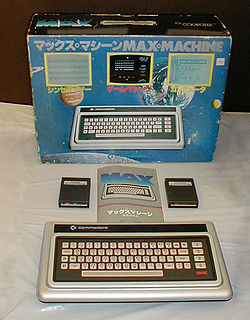This is an old revision of this page, as edited by Silver Edge (talk | contribs) at 04:36, 4 July 2008 (Undid revision 223459574 by Incognito (talk), as per WP:LINKSPAM and WP:VG/EL). The present address (URL) is a permanent link to this revision, which may differ significantly from the current revision.
Revision as of 04:36, 4 July 2008 by Silver Edge (talk | contribs) (Undid revision 223459574 by Incognito (talk), as per WP:LINKSPAM and WP:VG/EL)(diff) ← Previous revision | Latest revision (diff) | Newer revision → (diff) | |
| Type | Console / Home computer |
|---|---|
| Release date | 1982 |
| Discontinued | 1982 |
| Operating system | MAX BASIC (Cartridge) |
| CPU | MOS Technology 6510 @ 1.02MHz |
| Memory | 2.5 KiB |
The Commodore MAX Machine, also known as Ultimax in the United States and VC-10 in Germany, was a home computer designed and sold by Commodore International in Japan, beginning in early 1982, a predecessor to the popular Commodore 64. The Commodore 64 manual mentions the machine by name, suggesting that Commodore intended to sell the machine internationally; however, it is unclear whether the machine was ever actually sold outside of Japan. It is considered a rarity.
Software loaded from plug-in cartridges and the unit had a membrane keyboard and only had 2.5 KiB of RAM internally. It used a television set for a display. It used the same chipset and CPU as the Commodore 64, and MAX cartridges will work in the C-64. It was possible to use a tape drive for storage, but it lacked the serial and user ports necessary to connect a disk drive, printer, or modem.
It was intended to sell for around $200 US. Although the MAX had better graphics and sound capability, Commodore's own VIC-20, which sold for around the same amount of money, was much more expandable, had a much larger software library, and had a better keyboard--all of which made it more attractive to consumers.
Unlike the C-64, the MAX never sold well and was quickly discontinued.